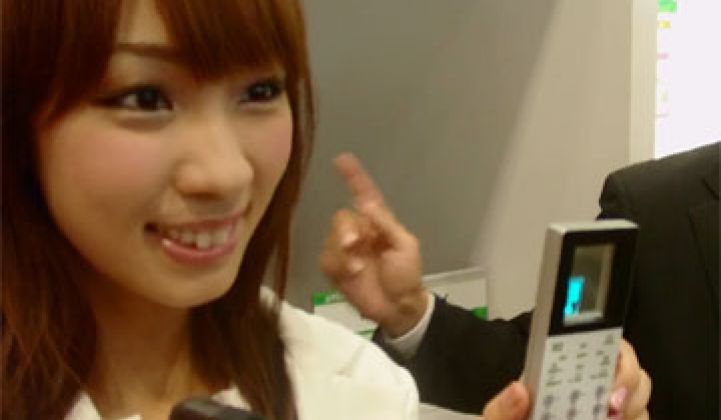Chiba, Japan -- Electronics manufacturers have taken fairly impressive strides in increasing their energy efficiency in recent years. Some classes of components are already in the 80-to-90-percent efficiency range.
So what will they do for an encore? Take out the bulk.
The flexible organic light emitting diode (OLED) display in the video below was one of the more impressive demos at Ceatec, the large technology trade show taking place outside of Tokyo. (I'm chairing the "Best of Show" committee.) It measures 0.3 millimeters thick, but it can play video in color. If you’re looking for Harry Potter-like moving newspapers, here’s your answer.
The screen is experimental, but if the sizes can be increased and the cost can be lowered a la Moore's Law, one can imagine how this technology could put a dent in demand for raw and industrial materials like copper, resins, and glass. Lower demand for these kinds of materials would in turn lower the amount of emissions from mining, transportation and production.
Now take a look at this second OLED screen from TDK. On one side, you can see an image. On the other side, it’s clear. With something like this, a smart phone could be reduced to something that resembles a piece of Lucite. (Unlike the first screen, this one is encased between sheets of glass.) No one would know what you are typing.
A thin film for touch screen buttons could be incorporated into the mix so you could dial numbers on your Lucite tablet.
Just as important: these two screens begin to exploit the aesthetic possibilities of OLEDs. A number of manufacturers, even solar manufacturer Moser Baer, are trying to exploit the same thin, flexible properties for lighting.
And then there’s this: an electrostatic speaker from Yamaha. That sheet of material that looks like a pad of easel paper in the video is the speaker. It’s about a centimeter thick but fairly loud. You can stand 18 meters away and still pick up music or other audio.
The speaker is also directional, so if you stand just to the side of it you won’t hear a thing. (Warning: the auditorium was fairly loud so it is somewhat difficult to separate the soundtrack coming from the speakers and the screaming and yelling in the convention center. Some of the camera angles are downright crazy because of audio issues. Still, you get a sense of how it works.)
Yamaha will initially target hotels and advertisers with the product, but it could make it into homes in the not incredibly distant future.
Like the OLED screens, the key green takeaway here is that the technology could substantially reduce the raw materials required for finished goods and demand for energy in manufacturing. It even potentially reduces the stress on the recycling system. Many types of thin films are relatively easy to recycle.
Additionally, it is the kind of product that won’t have to rely on eco-benefits or a utilitarian cost-benefit analysis alone to get sales. Instead, consumers may buy it because of the 'Wow!' factor.
Consumer lust: many green industries need to figure out how to tap into that emotion.



